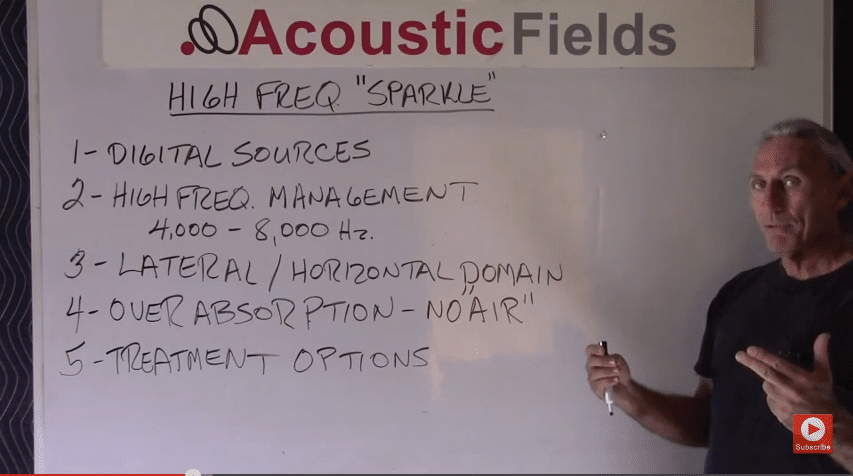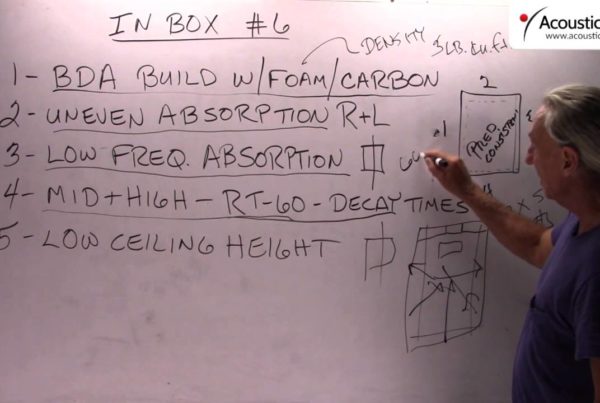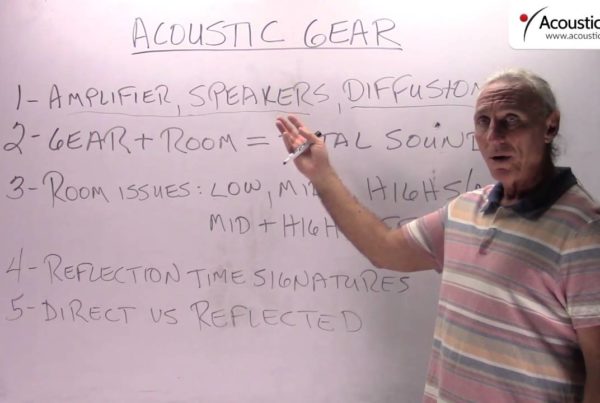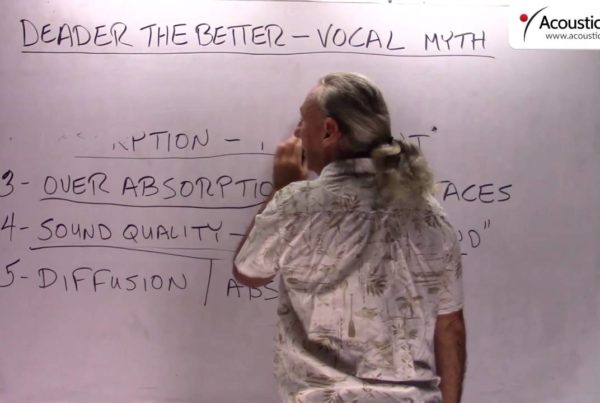Today, we’re going to talk about high frequency sparkle. Not a very scientific name I’ll grant you but something I think we need to talk about especially with today’s digital sources. There is a lot of clarity, resolution in our higher frequencies that 4,000 to 8,000 cycle range and it bothers people and it bites, it irritates especially over long listening periods and I think we are all kind of familiar with it. That 4,000 to 8,000 cycle range I see consistently in rooms that we measure and test and I see a lot of times that it’s over absorb. There is a lot of over absorption of that energy and we have to be really careful with too much absorption in that area and why, because that’s the air, sort to speak that people talk about in our presentations.
A cymbal, anything that generates high frequency. A rim shot on a drum. Those can really be made in your room to suspend in air and have a nice quality of sound to them but if you over absorb them, and that’s the naturally tendency to do because they are fatiguing, they are nasty over long periods of time especially as an engineer if you are working with it. I can’t tell you in the last 2 weeks I think I’ve measured 7, 8 rooms and that 4,000 and 8,000 cycle range is predominant in all rooms. We want to be very careful about how we manage that domain because it does provide a lot of air, a lot of separation and there is some great definition and some emotional feelings and responses in that range.
We have to be careful with how we manage it and be very careful with over absorption. Now it’s our treatment options usually exist in the lateral or horizontal domain. If our room is here and our speakers are here, we really look at the lateral domains for our treatment. Here is an idea that we’ve discovered in our studio because we are guilty of the same thing. I can’t stand that 4,000 to 8,000 cycle range even though I’m older and don’t hear as much of it as you younger guys out there and people do but it still bothers me.
Over absorption is not the answer. The answer is to manage it, get your definition through absorption, get the right amounts, rates and levels of absorption to give you the definition that you want, but then use diffusion in the domain that you need to use. Now what domain is that? Well, what we’ve discovered if you stay out of the horizontal or side wall domain, and go above it, if this is your side wall and here is your speaker, we’ve been working with diffusion up here in the horizontal dimension above the speakers and we are finding that we get a lot of air back into the presentation and it doesn’t take that much surface area to treat.
In fact, in our studio now, we are using 1 or 2 of these higher frequency diffusers on to side walls and we are getting a lot more air back into our presentation but it’s not that brittle biting high frequency piercing that you get. We have to look at that. Now, what is an example, let me see if I can bring this over here for you. This is one of our diffusers that we use and it’s, I don’t remember what this one is based on what prime number it’s based on but basically this is 1,500 to about 4,000 cycles. We position this diffuser in the horizontal domain and we do it above the speakers around the room. You try different surfaces, try side walls surfaces first, try front and rear wall surfaces.
The solution would be to get definition and clarity through absorption but add that sparkle or air back into the presentation using some higher frequency quadratic diffusion. Sounds a little bit confusing. If you have any questions just call us and we’ll be able to help you on that. Higher frequency diffusion, you can see in graphic 7 that we don’t want to over damp and we have options in the higher domains of our listening environment to get that and we have a tool, quadratic diffusion, we don’t need lower frequency. We need frequencies that match the problems areas that we have.
In Summary
To learn more about room acoustics please sign up to download our free ebooks and video series on room acoustics here. And please let me know if you have any questions at any time.
Thanks
Dennis Foley








We use broadband absorption in the two most critical frequency regions in small rooms. Our Diaphragmatic absorbers, ACDA series, have…
Interesting web site and provocative introduction. Please check your copy for typos, otherwise nicely presented. I would like to see…
There is no such thing as soundproof anything especially carpet. Low frequency noise transmission requires a permanent construction fix with…
Hello Dennis! Our neighbors put a Ice Bath in their garage which is right below our bedroom and the Low…